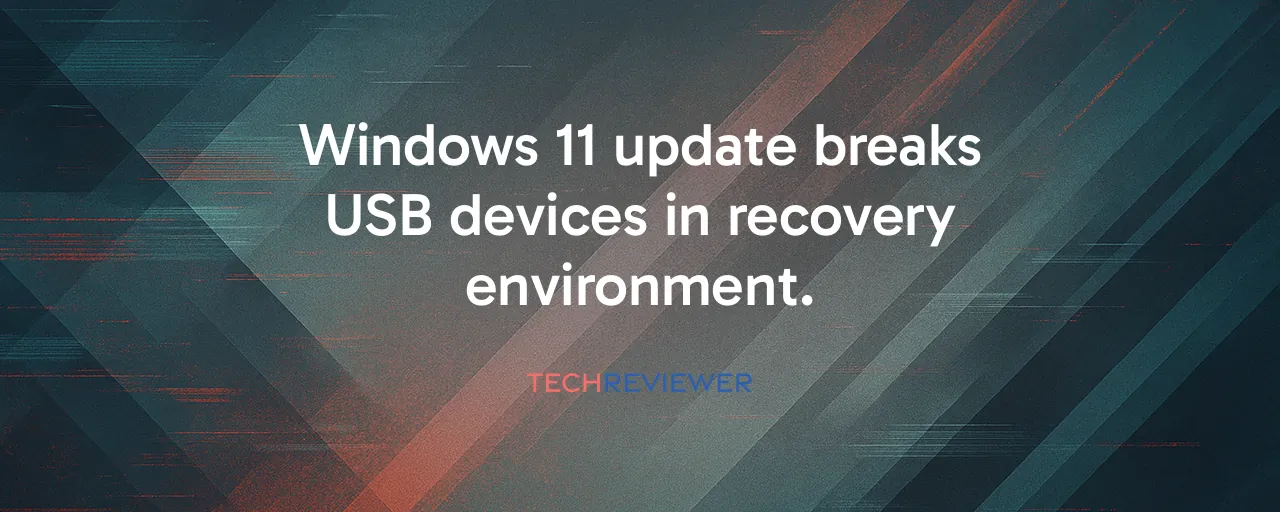A Recovery Roadblock Hits Windows 11
A recent Windows 11 security update, meant to protect millions of devices, has instead left users in a bind. Released on October 14, 2025, the KB5066835 patch tackled 172 vulnerabilities, including six zero-day exploits. But it also introduced a serious flaw: USB keyboards and mice stop working entirely in the Windows Recovery Environment (WinRE), a critical tool for fixing boot failures. When a PC fails to start, WinRE is supposed to step in, offering options like system restore or safe mode. Without functional input devices, users are stuck and unable to navigate menus or initiate repairs.
This glitch caught users off guard especially since USB devices work fine in normal Windows operation. Only when WinRE loads do keyboards and mice become unresponsive, a problem tied to faulty USB driver initialization in the stripped-down recovery environment. Legacy PS/2 keyboards and mice, relics of older hardware, dodge the issue entirely, leaving a small group of users unaffected. Microsoft acknowledged the bug on October 17, 2025, promising a fix soon, but for now, many are left scrambling.
Real-World Fallout: From Home PCs to Enterprise Servers
The impact of this bug varies widely, hitting home users and enterprise IT teams in different ways. For individuals, especially those less tech-savvy, a boot failure now means a dead end. Without a working keyboard or mouse, they can't access recovery tools, restore backups, or even enter safe mode. Some have mistakenly assumed their USB peripherals are broken, potentially tossing out perfectly good hardware. Meanwhile, those with older PS/2 devices or the know-how to create bootable recovery media can work around the issue, highlighting a gap between technical haves and have-nots.
In enterprises, the stakes are higher. Take Intel NUC systems, compact PCs often used in businesses, which rely solely on USB 3.0 ports. When these systems hit a boot issue, WinRE's failure leaves IT admins unable to perform quick fixes, turning minor glitches into major downtime. Another case involved Noah System, a hearing aid programming software, where the same update caused localhost connectivity issues, disrupting workflows for healthcare providers independent of the WinRE problem. These dual failures with WinRE and localhost show how a single update can ripple across industries, from small clinics to large server rooms.
Why It Happened and What It Reveals
At its core, this bug stems from a failure in the WinRE USB driver stack, a minimal setup designed to keep the recovery environment lightweight. Unlike the full Windows OS, WinRE loads only essential drivers, and something in KB5066835 disrupted USB controller initialization. Technical discussions point to a possible hidden update, KB5067039, as a contributing factor, though the exact cause remains unclear. The fact that PS/2 devices work fine underscores the issue's specificity to USB architecture, which relies on complex driver handshakes absent in older, simpler systems.
This incident exposes deeper challenges in Microsoft's update process. Throughout 2025, Windows 11 updates have stumbled, from SSD failures in August to DRM issues in September. The rapid pace of mandatory security patches, driven by threats like zero-day exploits, often outstrips quality testing. Enterprises now face a dilemma: apply updates to stay secure or delay them to avoid disruptions. The WinRE bug, affecting both Windows 11 versions 24H2 and 25H2 and Windows Server 2025, shows how even critical recovery tools can fall through the cracks.
Navigating the Fix and Learning Lessons
Microsoft has stated a fix is coming in the next few days and is developing an out-of-band update, rather than waiting for November's Patch Tuesday. For now, workarounds are limited. Users with PS/2 peripherals can proceed as usual, but most rely on USB devices. Creating bootable USB recovery media from another system offers a solution, though it requires technical skill. Enterprises are advised to pause KB5066835 deployment where possible, using tools like Windows Update for Business to manage rollout delays.
The broader lesson here is about balancing speed and stability. The Intel NUC and Noah System cases illustrate how different bugs from the same update can disrupt distinct workflows, from office IT to specialized healthcare software. These incidents push companies to adopt defensive strategies, like staged rollouts or maintaining recovery media for every Windows version. For Microsoft, the fix is about rebuilding trust in a system where one update can break a lifeline like WinRE. Until the solution arrives, users and IT teams alike are holding their breath, hoping their systems don't crash.
